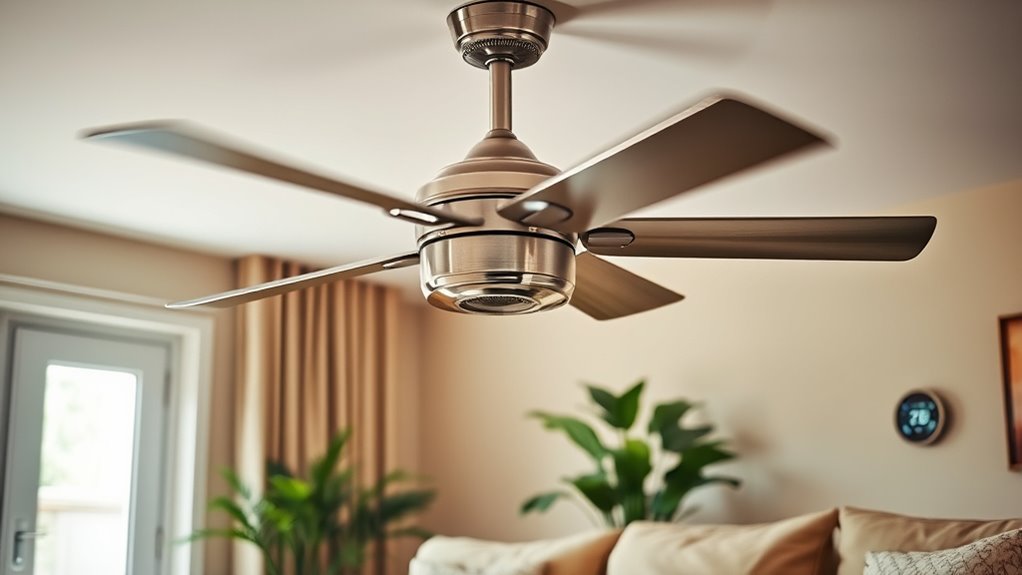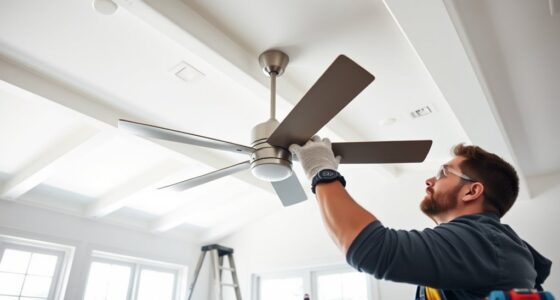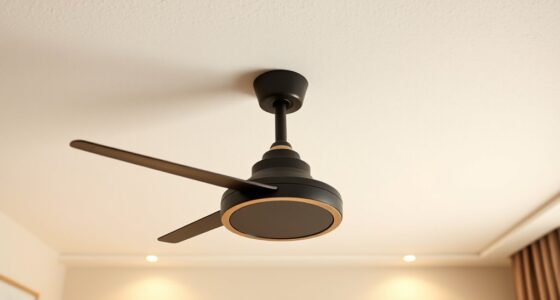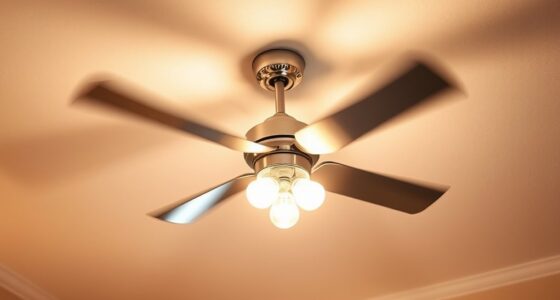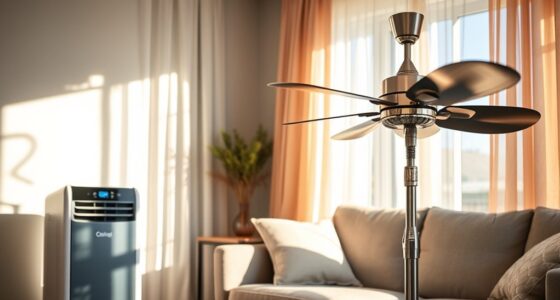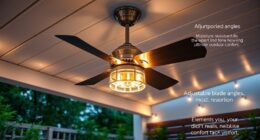Ceiling fans mainly cool by creating air movement that makes you feel more comfortable, but they don’t actually lower the room’s temperature. When the fan moves air across your skin, it speeds up evaporation and heat loss, giving you a cooling sensation. The room’s temperature stays the same, but you feel cooler due to increased airflow. To learn how ceiling fans can improve comfort and save energy, keep exploring these key points.
Key Takeaways
- Ceiling fans create air movement that makes people feel cooler by increasing evaporation, but they do not lower the actual room temperature.
- The primary function of ceiling fans is to improve personal comfort, not to cool the room itself.
- Fans help distribute warm or cool air evenly, preventing hot or cold spots, enhancing overall room comfort.
- Using ceiling fans alongside air conditioning can reduce energy costs without significantly changing the actual room temperature.
- Ceiling fans are most effective in moderate or cooler outdoor temperatures and do not replace cooling systems for lowering room temperature.

When the heat rises, ceiling fans offer an effective way to cool your room without cranking up the air conditioning. They work by creating air circulation, which helps to make you feel cooler even if the temperature of the room itself doesn’t drop considerably. As the blades spin, they move air across your skin, increasing evaporation and helping you shed heat naturally. This process doesn’t lower the actual temperature, but it improves your comfort level, making the room feel cooler. This is why understanding how precious metals are used as hedges against inflation can be an important part of long-term financial planning. Because of this, many people wonder if ceiling fans truly cool rooms or just the people inside them.
Ceiling fans primarily influence how you perceive temperature rather than changing the room’s air temperature. When you’re sitting under a fan, the moving air accelerates the evaporation of sweat from your skin, which tricks your body into feeling cooler. If you turn off the fan, the room might stay the same temperature, but you’ll notice yourself feeling warmer because the air isn’t circulating around you anymore. So, in essence, ceiling fans are more about personal comfort than actual room cooling. However, their ability to increase air circulation can contribute to a more evenly distributed temperature, preventing hot spots and making the entire space feel more comfortable.
Ceiling fans enhance comfort by increasing air circulation and even temperature distribution, not by lowering room temperature.
Another key advantage of ceiling fans is their energy efficiency. They consume far less electricity than air conditioning units, making them a cost-effective choice for maintaining comfort. Running a ceiling fan uses only a small fraction of the energy that an air conditioner does, which can considerably reduce your energy bills. Plus, with the right settings and placement, ceiling fans can complement your cooling system, allowing you to set the thermostat higher and still stay comfortable. This synergy not only saves energy but also extends the lifespan of your air conditioning system.
It’s important to remember that ceiling fans don’t actually lower the temperature of a room. Instead, they help you feel cooler by enhancing air circulation. They’re most effective in rooms where the temperature isn’t excessively high or in climates where the outdoor air is relatively cool. When used strategically, ceiling fans improve energy efficiency and boost your overall comfort. They’re a smart addition to your home, especially during warmer months, because they help you enjoy a cooler feeling without the added cost and energy consumption of constantly running the AC. So, while they may not technically cool the room’s air, they do a great job of making you feel cooler and more comfortable.
Frequently Asked Questions
Do Ceiling Fans Help Reduce Indoor Humidity Levels?
Ceiling fans don’t directly lower indoor humidity levels, but they do improve air circulation, which can make a space feel cooler and more comfortable. By moving air around, fans help humidity evaporate from your skin, giving a cooling sensation. While they don’t control humidity itself, they enhance overall humidity control by promoting better air movement, making your environment feel less sticky and more pleasant.
Can Ceiling Fans Be Effective in Very Humid Climates?
In very humid climates, ceiling fans can improve comfort but don’t directly reduce humidity levels. They help with humidity control by promoting air circulation, which makes the air feel cooler and less sticky. For maximum effectiveness, you should consider proper fan placement—high on the ceiling and directed downward—so air moves efficiently across the room. While they don’t lower humidity, they make the environment feel more comfortable.
How Do Ceiling Fans Impact Energy Consumption?
Ceiling fans impact your energy consumption by offering energy savings through improved fan efficiency. They use less electricity than air conditioners, helping you cut cooling costs. When you run a ceiling fan, it circulates air, making the room feel cooler without lowering the temperature. This way, you can set your thermostat higher and still stay comfortable, reducing overall energy use and saving you money on your utility bills.
Are Ceiling Fans Suitable for Outdoor or Covered Patio Areas?
Think of your patio as a stage where outdoor lighting and decor set the scene. Ceiling fans, like gentle guardians, enhance this space, making it more comfortable. They’re perfect for outdoor or covered patio areas, providing a invigorating breeze without disrupting your ambiance. Just guarantee you select fans rated for outdoor use to withstand weather. This way, your patio remains inviting, functional, and beautifully integrated into your outdoor decor.
Do Ceiling Fans Work Better With Air Conditioning Systems?
Ceiling fans work well with air conditioning systems to enhance thermal comfort by improving air circulation. When used together, fans help distribute cooled air evenly, making the room feel cooler and more comfortable. They don’t lower the temperature directly but boost the air movement, which can make you feel cooler. So, combining ceiling fans with air conditioning is an effective way to maximize comfort and reduce energy costs.
Conclusion
So, while your ceiling fan might not turn your room into an Arctic escape, it’s certainly your best ally in keeping you comfortable. Think of it as a gentle breeze whispering coolness your way, making those warmer days feel just a tad more bearable. Remember, it’s more about creating a invigorating ambiance for you than dropping the thermostat’s temperature. With a ceiling fan, you’re not just cooling the air—you’re inviting a touch of cool comfort into your everyday life.
